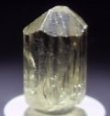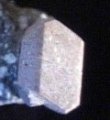 | |||||
| About Us | Contact Us | Services | Copyright | |||||
|
|||||
|
How to tell Minerals Apart By Marilyn Fraser
ColourColour is an important key to identifying your specimen – just as its important to be able to tell an apple from a pear.LusterAnother important thing to notice when identifying a mineral is the shine – known as luster – whether it looks like metal (metallic) or glass, like diamond or silky.StreakThe streak made by a mineral is often a different colour than the mineral itself. The streak is found by rubbing the mineral on an unglazed piece of ceramic tile. The colour of the streak is important in helping you identify the mineral.HardnessAnother important factor in knowing your rocks is the hardness. A common system of measuring hardness is the Mohs Scale. The scale runs fron the softest mineral, talc, as "Mohs 1" to the hardest mineral, diamond, as "Mohs 10". (The pictures to the right show what these minerals look like).The Mohs Scale:
In the beginning you can use four categories of hardness:
Your fingernail has a hardness of 2.5. If you can scratch your mineral or rock with your fingernail, you know it is softer than 2.5. A pocket knife has a hardness of 5.5 and quartz has a hardness of 7. If you can scratch it with your pocket knife, you know it is softer than 5.5.
This article may not be copied, distributed or reprinted in any form without the author's permission. To contact the author, please use the e-mail address provided. If you are unable to contact the author, please contact the Canadian Rockhound. Authorized reprints must acknowledge the author, original source and the Canadian Rockhound, and include the website URL address of the Canadian Rockhound. Images of Mohs scale minerals are Copyright ©1995-1996 by Amethyst Galleries, Inc., and are used here for educational purposes only.
|
||||

Copyright © 2000 Canadian Rockhound
Magazine Issues |
News & Events |
Junior Rockhound |
Resources
|
||||









